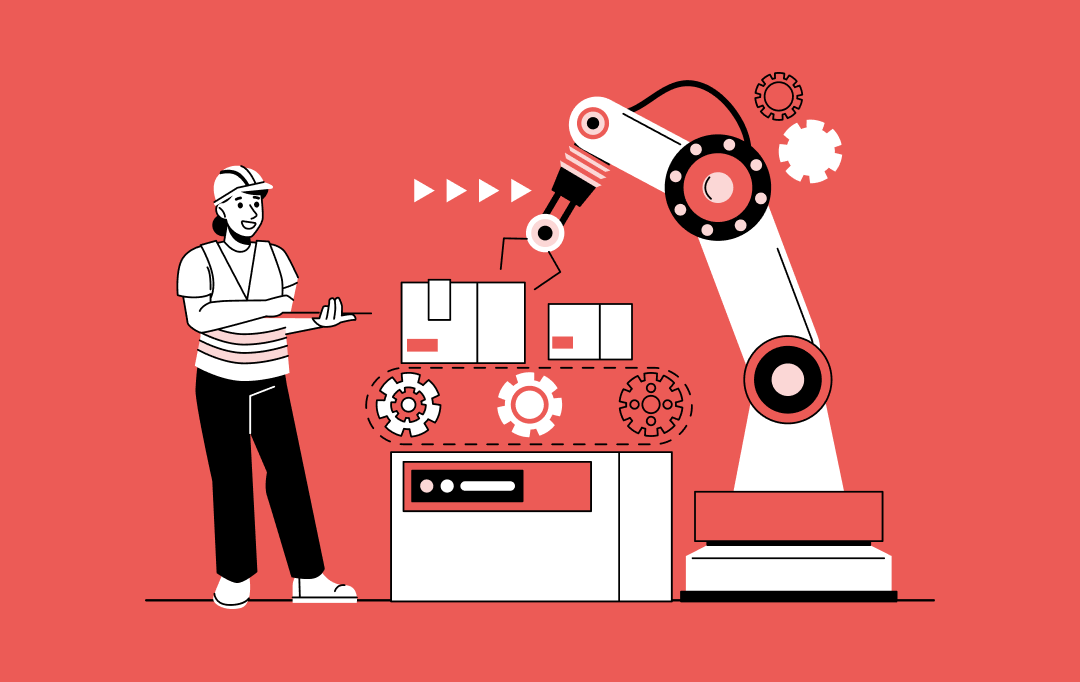- What is An Integrated Data Infrastructure for Business?
- Why is Data Infrastructure Important For Your Business?
- 1. Improved data sharing and data security
- 2. Effective data integration
- 3. Consistent and reliable data
- 4. Data complied with privacy regulations
- 5. Better decision making
- Types of Data Infrastructure For Businesses To Implement
- Top Five Business Data Infrastructure Trends To Follow in 2024 and Beyond
- 1. Data fabric
- 2. Data mesh architecture
- 3. Decision Intelligence
- 4. Monolithic architecture
- 5. Small and wide data analytics
- How Can Appinventiv Help You With Modern Data Infrastructure Solutions?
Data has the potential to drive and scale any business, economy and country, giving directions in forming valuable strategic decisions. With the enterprise digitization era surrounding us, businesses’ need for data impaired with modern technologies such as AI/ML and IoT (Internet of Things) has increased more than ever. This calls for a well-built data infrastructure where your business data can be maintained, organized and distributed in the form of insights.
As an essential part of the entire business data center and warehouse, the data support infrastructure consists of power, cooling, security, monitoring and measurement systems, all designed to provide assistance in maintaining core business data operations.
According to Grand View Research, the global market for data center support infrastructure was valued at $2.1 billion in 2021 and is expected to reach $7.79 billion in 2030, witnessing a CAGR of 15.9% from 2022 to 2030. The growth of modern data infrastructure is fueled by the rapidly rising volumes of data that need to be stored and managed in an efficient manner.
Besides, there is a continuous demand for cloud data storage, online mobile cloud computing services, data visualization and big data analytics leading to sustainable market growth of data infrastructure solutions.
According to Gartner, by the year 2027, half of the essential applications used by enterprises won’t be hosted on centralized public cloud platforms.Instead, these critical applications will be found in private clouds, on-premises data centers, edge computing environments, or decentralized cloud infrastructures.
This shift implies that having a robust and adaptable data infrastructure is crucial for effectively managing data assets and supporting business processes in a changing technological landscape.
So what are we waiting for? It’s time we take a detailed look at ;
- What is an integrated data infrastructure?
- Why does your business need a modern data infrastructure?
- Data infrastructure types for your business
- Top five data infrastructure trends for 2024 and beyond, shaping the future of your business
What is An Integrated Data Infrastructure for Business?
A data infrastructure consists of data assets and can be seen as an ecosystem of processes, technologies and systems to collect, store, maintain and distribute data for business purposes.
In short the accurate data infrastructure definition would be:
“Data Infrastructure consists of Data Assets, both structured and unstructured, supported by Process, People and Technology”.
Here are some of the primary characteristics of modern data infrastructure:
- An integrated Data infrastructure involves- technologies and standards to curate and provide access to all business data resources
- Guidance and policies to inform the use and management of data assets and its systems
- Data sets, identifiers and registers to analyze customer data ecosystem and business data ecosystem individually
While many organizations use a software-defined infrastructure (SDI) to support the dynamic IT needs in businesses, SDI has its own backlogs. One of the most popular data infrastructure trends is to implement ADI, also known as, Artificial Intelligence defined Data infrastructure.
ADI is an intelligent upgrade of Software based data infrastructures stacked up with modern AI/ML algorithms to backup your business data in every possible manner.
We will talk about more data infrastructure trends in detail, however, for now, let’s take an overview on why your business is in immense need of data infrastructure management solutions.
Why is Data Infrastructure Important For Your Business?
A strong data analytics infrastructure strategy ensures enhanced productivity and efficiency, makes collaboration with resources easier and allows easy access of information remotely, provided that you have properly implemented data infrastructure systems in your workflow.
Some of the primary benefits of using data infrastructure solutions are:
1. Improved data sharing and data security
Data infrastructure helps businesses share data quickly, effectively and securely across various organizations. You get quick solutions to database query, moreover, the end users are able to speed up the work process.
For instance, with an integrated data infrastructure, your sales team would get resourceable data insights where they can prospect sales accurately in the provided period.
2. Effective data integration
The need for a modern data ecosystem is significant since it helps promote a more accurate picture of your operations and data management. Data infrastructure determines how one segment of your business is affected by other segments.
Therefore, you can integrate various data standardization options such as APIs and integration, data processing, networks and more to enrich your data sets.
3. Consistent and reliable data
Data inconsistency is by far the most common challenge to every business vertical. Data infrastructure with the help of certain data quality tools makes sure that the accurate view of data is shared throughout the organization.
4. Data complied with privacy regulations
Data infrastructure ecosystem provides a better framework for the enforcement of privacy and security policies. By orchestrating data in a unified manner, you can centrally manage data privacy and security with lower risk of regulatory violations.
5. Better decision making
Decisions made on data are good as information used. Data infrastructure systems help provide data quality initiatives and better data management with reduced operational costs.This ultimately leads to better organizational decision making.
This is probably why your business needs a reliable data infrastructure. If you are convinced to deploy a data infrastructure ecosystem to workflow, the common deployment options are on-premise deployment, cloud deployment and hybrid deployment.
As for the banking and supply chain industry, their workflow is moving further to cloud native and serverless infrastructure for data hosting and reduced workload.
However, it’s best to know what type of data infrastructure your business needs before you deploy the ecosystem across your enterprise.
Types of Data Infrastructure For Businesses To Implement

Data infrastructure can be classified into various categories based on the purpose and objective of the data used for your business. Following are some of the most common types of modern data management infrastructure systems used by enterprises to scale their everyday work processes:
Data access – Data access is an interface to move, copy, retrieve and modify data from IT systems to the requested access query. It is basically a medium where users get the required data in an authenticated and systematic method.
Data Ingestion – Data ingestion is the infrastructure where data is transported from one or multiple resources to a location where the data can be used for analysis and manipulation. The system is nothing but routing the data into the right direction.
API integration – As mentioned above, APIs are commonly used data infrastructure systems that process requests for seamless distribution of data through multiple devices. APIs communicate and interact with the backend systems along with our programs, devices and applications.
Data storage and processing – Data storage refers to the physical or virtual storage of data through various equipment and software.
An interface to control the data for effective management is called data processing. The process involves transforming raw data into insights. The collective process of both is called data integration.
Databases – Databases are a systematic and organized collection of data that can be accessed only through authentication. Databases, when in enormous amounts, are managed by large database management systems.
Networks – Networks infrastructure acts as a connection between company’s systems, mainframes, servers, network devices, peripherals etc. to share data efficiently.
Data security – Data security infrastructure involves systems, software, hardware and applications to protect data from unauthorized access. The ecosystem includes data encryption, hashing, tokenization for comprehensive protection across all digital platforms.
You may also want to read;
How to prevent data breach on your app and
Six proven ways to avoid data leakage in your Android app
Data centers – Data centers have the infrastructure or a dedicated space for storage of business applications and data. For instance, router, storage systems, firewalls, application delivery controllers etc.
Data visualization – data visualization is the representation of data in graphical form including dashboards, charts and maps for easy communication of insights.
Data migration – Data migration is performed with the cloud platforms where the internet based business data is stored and processed.
All these data processes are used by businesses of every scale and size to maintain and optimize their data silos. If you are still not convinced on how these data infrastructure systems can help you out; here’s an infographic depicting data infrastructure examples and use cases by tech giants.

Apart from these tech giants, data analytics is also a hit in the telecom industry. Discover how Appinventiv helped a leading telecom company build a customer centric data infrastructure platform increasing the data quality by 85%.
This is all we needed to know about data infrastructure before moving to the data infrastructure trends. Speaking of data trends, businesses are becoming smarter with integrating and managing enterprise data that is accessible, authenticated and governed.
For better data infrastructure management, organizations are placing emphasis on their backed systems in order to gain more customer facing assets and work better. Therefore, if you are looking to move beyond your business data and sustain your business process, here are top five data trends you can follow.
Top Five Business Data Infrastructure Trends To Follow in 2024 and Beyond
Data infrastructure trends are all about migrating to efficient data solutions, cleansing data, making better use of data assets and removing extensive data silos. Now that all industries and verticals are leveraging modern data processes, here are a few data infrastructure trends accelerating and shaping businesses:
1. Data fabric

Data fabric is the foundation for distributed enterprise. With the constant evolution of digital channels and online sales, there is a complex and diverse ecosystem of devices and applications. Businesses are now creating data fabric to drive enterprise wide data and analytics and automate all data processes.
Data fabric allows businesses to choose the most appropriate approach to manage their data which ultimately results in reduced time of delivery. Many studies have stated that “data fabric technology takes data virtualization to the next level by automating data management functions using AI and analytics.
2. Data mesh architecture

Data mesh architecture has become more enticing than ever. With the organization growing in size and complexity, usually central data teams are asked to deal with a wide array of functions. This makes it difficult to understand the data requirements of other cross functional teams, hence the businesses are unable to provide the right set of data products.
Data mesh is a decentralized architecture for data analytics that removes the bottlenecks and takes closer data decisions. In the upcoming years, if your business involves distributed data environments, data mesh is what you need for unified infrastructure to share your data products.
3. Decision Intelligence

Decision intelligence approach makes an inroad for business wide decision support. Businesses acquire vast amounts of data and leverage the information to drive successful business outcomes. With the decision intelligence approach, the data insights, regular dashboards, BI platforms are augmented with AI/ML and analytics capabilities to help support higher decision actions.
4. Monolithic architecture

Businesses have already embraced composable data and analytics architecture to empower data consumers. Although monolithic architecture is already a thing of the past, the process is about to be acquired by businesses in even small footprints. If your data is spread across cloud platforms, physical and regional servers and data center boundaries, it is practically impossible to have a central location to consolidate all data silos.
With composable data architecture, you have a leverage with low code or no code infrastructure providing you desired data management tech stack and making your business less dependent on IT.
5. Small and wide data analytics
As we know, modern technologies are transforming the way businesses operate. However, to be successful and relevant, businesses also need traditional analytics, BI and cloud and possible data tools. With wide data analytics, the infrastructure combines structured, unstructured and semi-structured data from various sources for analytical purposes and gives pace to the dataflow across the organization.
Small and wide data analytics is a new concept yet to be adopted, however, within months we will be able to see enterprises gaining better traction with this concept.
We believe we are still in the very early stages of a revolution in modern data analytics infrastructure. Just as AI and cloud computing changed the way we work, harnessing the modern data infrastructure trends can transform every business vertical and industry with its integrated and centralized approach. All you need is data infrastructure management services to guide you through the journey.
How Can Appinventiv Help You With Modern Data Infrastructure Solutions?
Appinventiv is a leading data management company specializing in data analytics solutions for businesses of every scale and size. Our rich pool services include analytics consulting, data warehousing, Big data, Data visualization, Business Intelligence and Supply chain analytics etc.
Our experts are known to follow an agile methodology and result oriented approach, offering end-to-end data solutions to your business.
Talk to our data experts to build a robust data infrastructure for your business now.



Unleashing the Role of Data Analytics in Driving Smarter Banking Decisions
The use of data analytics in banking is transforming how this data is interpreted and applied. Banks are using this data to make decisions that matter—fraud checks, loan approvals, or marketing campaigns. The focus has shifted: from storing data to using it smartly, and from pushing products to understanding people—being customer-centric. This shift is also…

10 Use Cases and Examples of How Pharmacy Data Analytics is Transforming Operations and CX
Data has become the currency of modern business, and the pharmacy sector is no exception. From inventory optimization to regulatory compliance, pharmacies today face many challenges that demand precision and agility. Well, pharma data analytics is solving all these conundrums as the main lead, a transformative approach that now empowers businesses to get actionable insights…

10 Use Cases and Benefits of Predictive Analytics in Manufacturing
Are you trying to stay in today’s manufacturing game with that old-school data analytics approach? Not gonna happen, buddy! Think about that old-school grind: manufacturing plant techies had to hustle around, scribbling notes and logging maintenance records by hand. All that manual intervention and hassle led to nothing more than messy data and bad calls.…

















